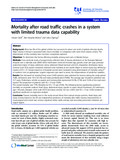| dc.description.abstract | Background
Africa has 4% of the global vehicles but accounts for about one tenth of global vehicular deaths. Major trauma in Kenya is associated with excess mortality in comparison with series from trauma centers. The determinants of this mortality have not been completely explored.
Objectives
To determine the factors affecting mortality among road users in Nairobi, Kenya.
Methods
Cross-sectional study of prospectively collected data of trauma admissions at the Kenyatta National Hospital over a calendar year (2009-2010). Information collected included age, gender, road user type, principal anatomical region of injury, admission status, admission blood pressure and GCS, disposition destination, Injury Severity Score (ISS), injuries sustained, treatment and mortality at two weeks. Major or severe injury was defined as injuries of ISS > 15. Groups based on in-hospital survival were compared using determinants of mortality using X2 or students t-test as appropriate. Logistic regression was used to assess the independence of predictive variables.
Results
One thousand six hundred forty seven (1647) patients were admitted for trauma during the study period. Traffic admissions were 1013 (61.7%) and males predominated (79.8%). The average age of patients admitted was 31.7 years. Pedestrians, vehicle occupants and motorcyclists represented 43.3%, 27.2% and 15.2% of the road users injured. The proportion of patients with ISS > 15 was 10.9%.
The overall mortality was 7.7%. Mortality for ISS > 15 was 27.6%. The following factors significantly predicted mortality on univariate analysis: head injury, abdominal injury, transfer in status, blood transfusion, ICU admission, age > 60 years, Glasgow coma scale (GCS) and injury severity. GCS (p = 0.001) and ISS > 15 (p < 0.05) remained significant predictors on regression analysis.
Conclusion
Trauma mortality rates in this study exceed those from mature trauma systems. Head injury and injury severity based on the ISS are independent predictors of mortality after traffic trauma. Improvements in neurosurgical and critical care services ingrained within wider primary and secondary prevention initiatives are logical targets. | en_US |

